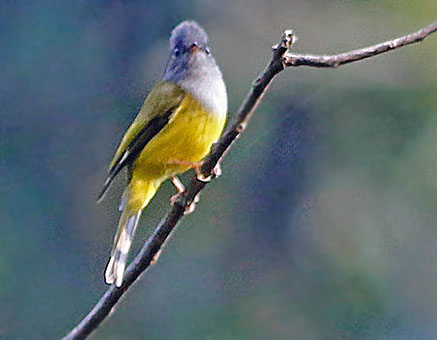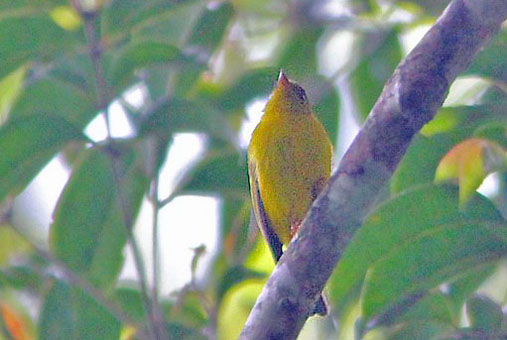
a web page by Don Roberson |
 |
||
FAIRY FLYCATCHERS [Stenostirids] Stenostiridae |
||
|
||
The five species of crested-flycatchers in genus Elminia were previously assigned to the Monarch family Monarchidae. The Monarchs are part of the great corvoid assemblage that arose in Australasia while the Stenostirids arose in either Africa or Asia. This the two groups are not closely related (Fuchs et al. 2009). |
||
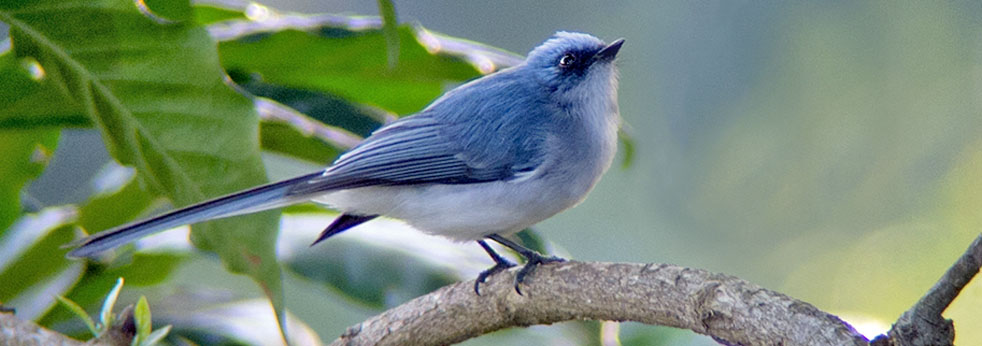 |
||
Beresford et al. (2005) proposed calling this new group the family Stenostiridae; Fuchs et al. (2009) proposed the formal description. The clade has been recovered in numerous studies and now appears certain. The current members include
To date there is no morphological character that unambiguously defines this family, although it is defined genetically (Fuchs et al. 2009). The species with the oldest name is Stenostira, so the family becomes the Stenostiridae. An English name for the family is the Fairy Flycatchers. I like the ring of the name, although I often use the term "stenostirids" for this group. This family does appear to include a radiation of flycatcher-like birds that have evolved to fit niches within forested settings that are filled by species in other families elsewhere. |
||
Sibley & Ahlquist (1990), working with DNA-DNA hybridization techniques, were the first to discover that the two canary-flycatchers in the genus Culicicapa, from the Oriental region, did not group with other muscicapid flycatchers with which they are traditionally been placed. They put them with the Australo-Papuan robins [Petroicidae, then called Eopsaltriidae] since the DNA hybridization results grouped more closely there. They did not anticipate the relationships that have now been discovered. The two canary-flycatchers — Gray-headed Canary-Flycatcher of southern Asia (below left) and Citrine Canary-Flycatcher of the Philippines, Sulawesi, the Sula Archipelago and nearby islands (below right) — are small, active, and conspicuous flycatchers in montane forests within their range. They perch upright, making typical fly-catching forays beneath of the canopy, and are often a member of mixed bird parties; Rasmussen & Anderton (2005). They thus resemble many muscicapid flycatchers, and do not behave like fantails. Beresford et al. (2005) were the first to show, through molecular evidence, that Culicicapa and Elminia were not only related to each other, but were closely related to a southern African enigma, "Fairy Warbler" (now Fairy Flycatcher) Stenostira scita. Sibley & Monroe (1990) had put Stenostira in the Acrocephalinae subfamily of the Old World Warblers "Sylviidae." The findings of these totally unexpected relationships overturned the apple cart. |
||
|
||
As we have seen, this lineage of flycatchers is interesting in that the currently-known members are African endemics (Stenostira, Elminia) and Indo-Malayan species (Chelidorynx, Culicicapa). The molecular evidence was that these new lineages evolved synchronously (Fuchs et al. 2009). Those authors draw a parallel between the rockjumpers of South Africa (Chaetops) and rail-babbler of southeast Asia (Eupetes), which appear to be more closely related to each other than to anything else (Fjeldså & Bowie 2008). But that divergence occurred much earlier in the evolutionary time-scale. It just turned out that the African and Asia birds were part of the (then-undiscovered) stenostirid clade that separated geographically with the movement of continents. What other birds may also be in this family? Urban et al. (1997) suggested that the two species of tit-flycatchers in Africa (genus Myioparus) might be related to Stenostira. What of the three Erythrocercus flycatchers of Africa, which are not monarchs (Pasquet et al. 2002)? As it turns out, the tit-flycatchers are solidly in the Muscicapidae, and "Myioparus" has been merged into Fraseria (Sangster et al. 2010, Zuccon & Ericson 2010). The three Erythrocercus flycatchers proved to be part of a cettid assemblage that is typically placed in a larger family Scotocercidae. Alström et al. (2011) discovered that the Old World desert species Scrub Warbler Scotocerca inquieta was not a cisticolid but nearer the cettids, and then Fregin et al. (2012) proposed the family Scotocercidae for just that one bird. Fregin et al. (2012) also found that the three Erythrocercus flycatchers were sister to a clade of cettids + scrub warbler, and also propose elevating them to Family level status with the formal name Erythrocercidae. I've taken a middle course. I lump Scrub Warbler with the rest of the warblers in Cettidae (which now becomes Scotocercidae as the senior name), but retain the three African flycatchers in family Erythrocercidae. Like the flycatchers now in Stenostiridae, the Erythrocercidae are another set of unrelated "flycatchers" in the Old World. |
||
Alström et al. (2014) undertook to study the relationships between some of these new families within the entire Passerida assemblage. They state: "This study is the first to our knowledge to provide strong support for a clade comprising Sylvioidea, Remizidae + Paridae, Stenostiridae and Hyliotidae, and another one containing Muscicapoidea, Certhioidea and the ‘bombycillids’. However, the relationships among these and the other basal lineages within Passerida remain uncertain, probably due to an explosive divergence of these primary lineages, as suggested by the phylogeny." World checklists now generally conform to these findings in arranging the list of passerine families in an overall taxonomy. Finally, as to the stenostirids, there is the issue of English names for members of the family. Obviously the black-and-white Fairy Flycatcher Stenostira scita, of southern Africa, is a great starting point, but it is just a single species in a monotypic genus. Today's genus Elminia is comprised of two species of "blue flycatcher" [the original Elminia] and three species of "crested-flycatcher" [formerly assigned to Trochocercus]. These five are now merged in Elminia. Dickinson (2003) proposed that all Elminia flycatchers now be called "crested flycatchers." This has the effect of changing the English name of "African Blue-Flycatcher" to Blue Crested-Flycatcher, and the name "White-tailed Blue-Flycatcher" to Blue-and-white Crested-Flycatcher. I initially liked these name changes because there are 17 species in genus Cyornis in Asia that are called "Blue Flycatchers," and these are all muscicapid flycatchers [family Muscicapidae]. Yet, the remaining two members of genus Trochocercus are now called "Crested-Flycatchers" and they are in the Monarch family. So no matter which way one goes on names, we have a muddle of English names scattered among three unrelated families of Old World "flycatchers." For the moment I use eBird/Clement English names, but I'm not sure they are the best ones. |
||
Photos: The African Blue Flycatcher Elminia longicauda was at Mole NP, Ghana, on 13 Dec 2013. My photo of White-tailed Blue Flycatcher Elminia albicauda in the canopy was at Gibbs Farm, Tanzania, on 10 June 2018; Joe Morlan took the portrait of this species, also at Gibbs Farm, on 6 July 2013.The Yellow-bellied Fairy-Fantail Chelidorynx hypoxanthus was along Zhemgang Rd., Bhuton, on 29 Mar 2019. The Gray-headed Canary-Flycatcher Culicicapa ceylonensis was at Morong, Bhutan, on 18 Mar 2019. The Citrine Canary-Flycatcher Culicicapa helianthea was at Lore Lindu NP, Sulawesi, Indonesia, on 27 Sep 2013.
Bibliographic note: There is no "family book" for this newly discovered family. The species in it were considered within the scope of their traditionally assigned families in the Handbook of the Birds of the World series. Literature cited:
|
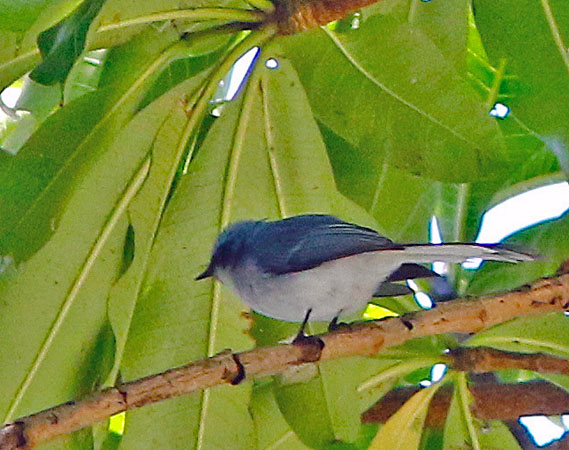 Molecular studies have recently discovered new and ancient lineages of birds that had not previously been anticipated. One of these is a lineage of flycatchers in Africa and tropical Asia that has been formally named the Stenostiridae (Fuchs et al. 2009). These are mostly tropical birds, and many behave like fantails, spreading and twitching their tails as they forage through the canopy of tall forests, or in the understory. The five species in the genus Elminia make up more than half of this new family. Examples in tropical Africa include African Blue Flycatcher (above, skulking along a riverbank in Ghana), and White-tailed Blue Flycatcher (sometimes called "Blue-and-white Crested-Flycatcher," left & below). The latter photo is a nice shot by Joe Morlan; we both took our photos at Gibbs Farm, on the flank of Ngorongoro Crater, in different years.
Molecular studies have recently discovered new and ancient lineages of birds that had not previously been anticipated. One of these is a lineage of flycatchers in Africa and tropical Asia that has been formally named the Stenostiridae (Fuchs et al. 2009). These are mostly tropical birds, and many behave like fantails, spreading and twitching their tails as they forage through the canopy of tall forests, or in the understory. The five species in the genus Elminia make up more than half of this new family. Examples in tropical Africa include African Blue Flycatcher (above, skulking along a riverbank in Ghana), and White-tailed Blue Flycatcher (sometimes called "Blue-and-white Crested-Flycatcher," left & below). The latter photo is a nice shot by Joe Morlan; we both took our photos at Gibbs Farm, on the flank of Ngorongoro Crater, in different years.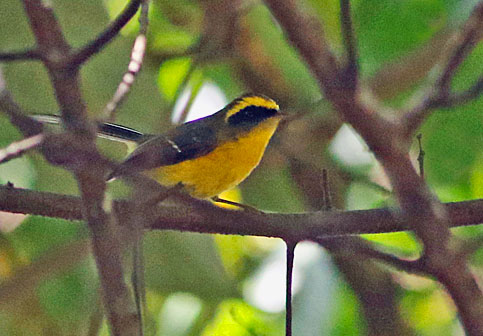 The last stenostirid to be discovered was a bird that traditionally was considered a "fantail" in genus Rhipidura: the Yellow-bellied Fantail "R. hypoxantha" of the Himalayas. It is now returned to its original genus (Chelidorynx) and becomes a "fairy-fantail," the ninth member of the Stenostiridae (Fuchs et al. 2009). Yellow-bellied Fairy-Fantail (right) joins mixed species flocks in the subtropical zone of the eastern Himalayas.
The last stenostirid to be discovered was a bird that traditionally was considered a "fantail" in genus Rhipidura: the Yellow-bellied Fantail "R. hypoxantha" of the Himalayas. It is now returned to its original genus (Chelidorynx) and becomes a "fairy-fantail," the ninth member of the Stenostiridae (Fuchs et al. 2009). Yellow-bellied Fairy-Fantail (right) joins mixed species flocks in the subtropical zone of the eastern Himalayas.